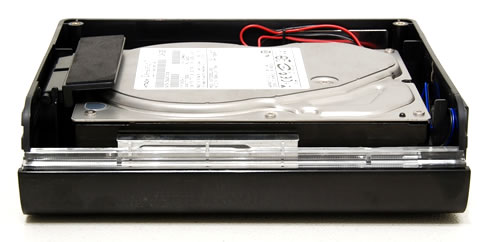A Closer Look & Installation
The provided cable measures only 40 inches, not even 3.5' long. If you are using the enclosure with a desktop resting on the ground, you may come up short depending on exactly where the computer is sitting and the size of your desk. A couple extra feet in length would be appreciated, especially considering that there isn't a maximum length restriction on USB 3.0 cables.
The enclosure itself is constructed of black plastic and brushed aluminum and is strikingly similar to Western Digital's My Book external hard drive. A vertical transparent strip runs the length of the enclosure on the front and is illuminated with a solid blue LED when on that flickers when the drive inside is being accessed.



The left side of the enclosure features a small cooling fan that draws air in and expels it via slotted vents on top of the enclosure. On the back of the enclosure is a power switch, on/off fan control switch, USB 3.0 port and DC power jack. The right side of the drive is mostly black with white lettering displaying the product name, etc. On the bottom of the enclosure are two large rubber feet.
To open the enclosure, lay it on its side with the fan facing down and remove the two Philips screws on the right side to remove the panel. To install a drive, flip up the wedge in the back of the enclosure, insert a 3.5" drive and slide it into the SATA connectors. Flip the wedge back down into position to secure the drive. For thinner drives, the included foam pads can be used.

While this toolless mounting method is nice, it means you can't install a smaller 2.5" drive like a solid state drive without some creative thinking. The odds of someone using a SSD as a storage drive is low and if that was the plan, they would likely pick up a 2.5"-specific enclosure, but the option to physically install a smaller drive on other 3.5" enclosures is nice. Once your drive is installed, simply replace the side panel and screw it back down.
Users without native USB 3.0 support will need an adapter card like the one StarTech provided us to use with their enclosure.

The adapter card is an x1 PCIe card that features a black PCB. The card draws power from a single 4-pin Molex connector. Each USB 3.0 port supplies 900mA of power, which StarTech claims provides 80% more power than USB 2.0 card.
Included with the card is a low profile bracket so you can use the adapter card in a low profile or small form factor system.